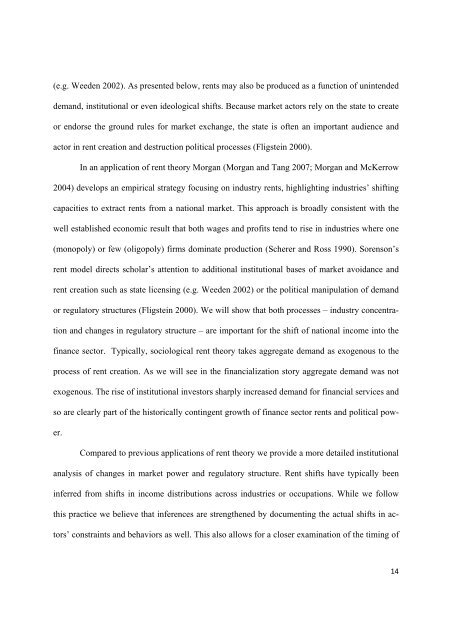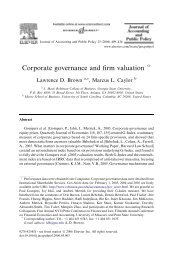Income Dynamics, Economic Rents and the Financialization of the ...
Income Dynamics, Economic Rents and the Financialization of the ...
Income Dynamics, Economic Rents and the Financialization of the ...
You also want an ePaper? Increase the reach of your titles
YUMPU automatically turns print PDFs into web optimized ePapers that Google loves.
(e.g. Weeden 2002). As presented below, rents may also be produced as a function <strong>of</strong> unintended<br />
dem<strong>and</strong>, institutional or even ideological shifts. Because market actors rely on <strong>the</strong> state to create<br />
or endorse <strong>the</strong> ground rules for market exchange, <strong>the</strong> state is <strong>of</strong>ten an important audience <strong>and</strong><br />
actor in rent creation <strong>and</strong> destruction political processes (Fligstein 2000).<br />
In an application <strong>of</strong> rent <strong>the</strong>ory Morgan (Morgan <strong>and</strong> Tang 2007; Morgan <strong>and</strong> McKerrow<br />
2004) develops an empirical strategy focusing on industry rents, highlighting industries’ shifting<br />
capacities to extract rents from a national market. This approach is broadly consistent with <strong>the</strong><br />
well established economic result that both wages <strong>and</strong> pr<strong>of</strong>its tend to rise in industries where one<br />
(monopoly) or few (oligopoly) firms dominate production (Scherer <strong>and</strong> Ross 1990). Sorenson’s<br />
rent model directs scholar’s attention to additional institutional bases <strong>of</strong> market avoidance <strong>and</strong><br />
rent creation such as state licensing (e.g. Weeden 2002) or <strong>the</strong> political manipulation <strong>of</strong> dem<strong>and</strong><br />
or regulatory structures (Fligstein 2000). We will show that both processes – industry concentra-<br />
tion <strong>and</strong> changes in regulatory structure – are important for <strong>the</strong> shift <strong>of</strong> national income into <strong>the</strong><br />
finance sector. Typically, sociological rent <strong>the</strong>ory takes aggregate dem<strong>and</strong> as exogenous to <strong>the</strong><br />
process <strong>of</strong> rent creation. As we will see in <strong>the</strong> financialization story aggregate dem<strong>and</strong> was not<br />
exogenous. The rise <strong>of</strong> institutional investors sharply increased dem<strong>and</strong> for financial services <strong>and</strong><br />
so are clearly part <strong>of</strong> <strong>the</strong> historically contingent growth <strong>of</strong> finance sector rents <strong>and</strong> political pow-<br />
er.<br />
Compared to previous applications <strong>of</strong> rent <strong>the</strong>ory we provide a more detailed institutional<br />
analysis <strong>of</strong> changes in market power <strong>and</strong> regulatory structure. Rent shifts have typically been<br />
inferred from shifts in income distributions across industries or occupations. While we follow<br />
this practice we believe that inferences are streng<strong>the</strong>ned by documenting <strong>the</strong> actual shifts in ac-<br />
tors’ constraints <strong>and</strong> behaviors as well. This also allows for a closer examination <strong>of</strong> <strong>the</strong> timing <strong>of</strong><br />
14







